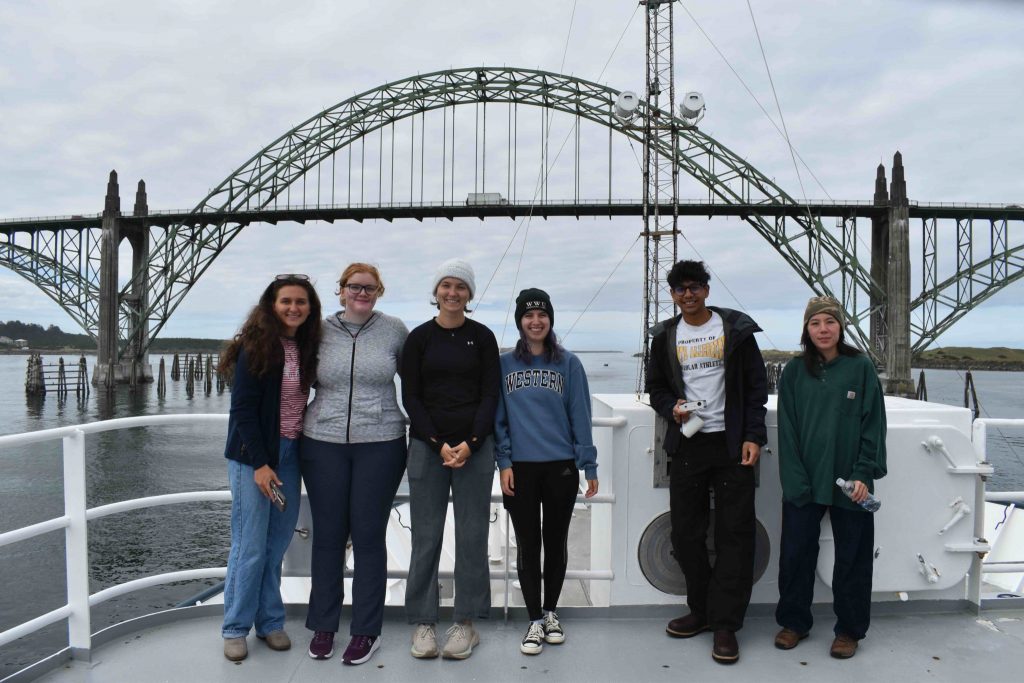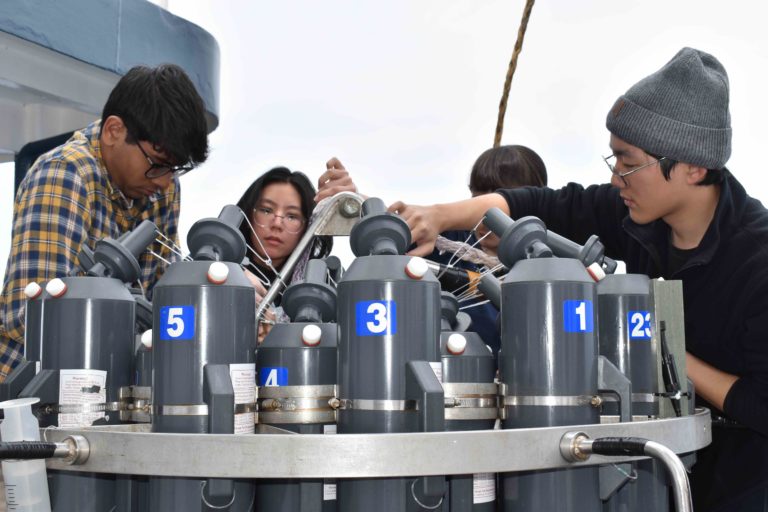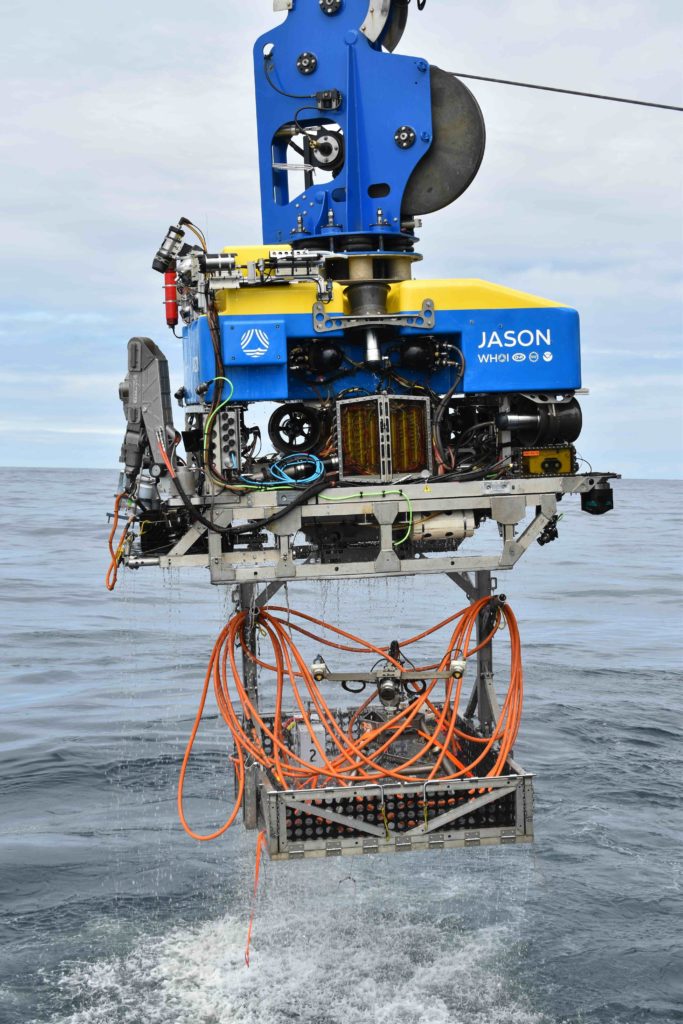Leg 1 of VISIONS 2025 (completed August 15) was successful in achieving all the planned science objectives, and two recovery dives at the end that were originally scheduled for Leg 2. During the 12 days at sea, the ship went to all Regional Cabled Array sites. The ROV Jason completed 27 dives. All the instrument packages on three Shallow Profiler Moorings were turned, 27 core instruments were recovered, 12 core instruments were deployed, and 5 CTD rosette casts and 22 ROV mounted Niskins were collected for instrument verification and calibration.
The R/V Atlantis departed Newport, OR on the cloudy morning of August 4 with a party of seven RCA science staff and seven engineers, and eight VISIONS’25 students. The weather conditions for the first few days of the cruise were calm, allowing us to hit the ground running. In short succession, a thorough ship safety meeting was followed by Jason control van training, and a CTD/rosette training before immediately jumping into a CTD cast and recovery dive on the Shallow Profiler Mooring at our first site, Oregon Offshore. We then moved to Slope Base, where another CTD cast was conducted and the instrumented platform interface assembly and winched science pod on the Shallow Profiler Mooring were turned. Our first seafloor operation was also at Slope Base (9500 ft beneath the oceans’ surface) during which Jason swapped the HPIES instrument, a spaghetti monster looking contraption that measures the vertical structure of the overlying water.
Our next operations took us to Axial Seamount for another Shallow Profiler Mooring set of dives where instruments at Axial Base (~2600 m depth) 25 km east of the summit of Axial Seamount were turned. The Atlantis then transit to the summit of Axial Seamount at the ASHES hydrothermal field where the high-definition video camera was turned as well as a conductivity, temperature, and pressure sensor, and an uncabled osmotic fluid sampler was recovered. The team got their first glimpse of the hydrothermal vents – a very exciting moment for our VISIONS’25 students for whom the ASHES Hydrothermal Vent Field was their first time seeing underwater hot springs and the amazing life forms that thrive within these novel environments.
The calm weather didn’t last forever. A high-pressure system brought increased wind and waves to our work sites and left behind a large and unpredictable swell that impacted our ability to dive, particularly at night for the middle of the leg. The team was highly flexible with these challenges, moving between sites and switching to dives without packages or dives with lighter packages to continue operations until weather improved. The calm conditions returned for our last two days allowing us to complete the last few operations before returning to Newport.
The Atlantis transited ~ 21 hrs to complete a multibeam sonar survey and dives at Southern Hydrate Ridge, a methane hydrate seep. Here, similar to hydrothermal vents, methane- and H2S –rich fluids support a thriving ecosystem. Once again, the sonar imaged active bubble plumes emanating SHR, and we were treated to seeing the source of one of these very active bubble plumes on the seafloor during the second dive at the site. The VISIONS’25 students were also very eager to see another novel chemosynthetic environment. Operations included swapping the digital still camera and recovering an osmotic fluid sampler and two flow meters.
When all scheduled work for Leg 1 was completed, the R/V Atlantis headed to the Oregon Shelf site 14 miles west of Newport (80 m water depth) where a zooplankton sonar and instrumented junction box were recovered. With those last two dives complete, the ship returned to Newport under rainy skies. Leg 2 will begin on August 17th, a new group of scientists and students will share their amazing experiences onboard the R/V Atlantis.
Extensive research cruises like ours require meticulous planning and involve many moving parts – emplying experts in a wide range of science and engineering. It is one of the most novel opportunities for undergraduate students and other interested parties to be introduced to ocean field experiences. It is no small feat for these novices to stand watch, log every ROV dive, assist with laboratory analysis, run taglines for a CTD/Rosette, and all the while think about projects for the accompanying fall class. Every year, new group of VISIONS’ students join this experiential learning program on the seas, working alongside our team of scientists and engineers. They leave their homes and live with us, the ship’s crew, and ROV Jason team who all work diligently 24 hours every day, and they do so enthusiastically. The Leg 1 VISIONS’25 students have taken to the ship and the work with passion, curiosity, and smiles. They’ve been eager to help with everything from cleaning instruments, to taking samples, and even help pack and move boxes while in port. In addition to their shifts in the logging van, helping with CTD casts or around the lab, they have also participated in daily meetings where they have created a list of people they are interested in hearing from who then come and talk to them if their schedule allows. The Leg 1 students’ daily meeting speakers highlight their curiosity in the full range of activities happening on the ship, having heard from a geologist, two APL engineers, one of the ship’s cooks, the Captain, and a member of the Jason team. Tomorrow, they will return to Seattle, then home, a bittersweet experience, but many with a newfound excitement and passion for the ocean, the incredible ecosystems found within, and how to study them.

VISIONS’25 and RCA team members gather on the Atlantis for a group photo at the end of Leg 1. Credit: T. Trudel, Jason Team, V25

Leg 1 VISIONS’25 students help cock Niskin bottles, reading the CTD for a cast at Axial Base. N. Vorobeyeva, University of Washington, V25.

The ROV recovers a digital still camera in the undervator at the end of dive J2-1719. Credit: N. Vorobyeva, University of Washington, V25.
Recent Updates